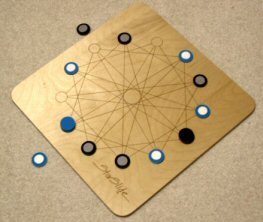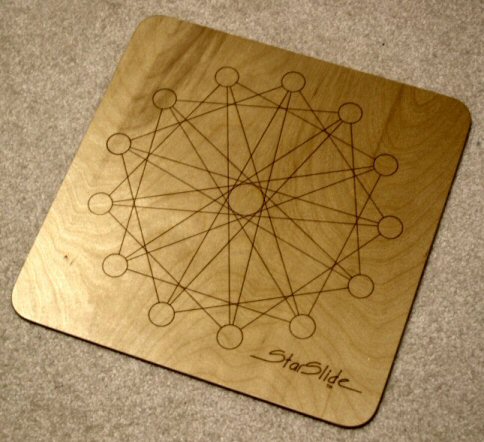 |
How to play StarSlideTM
- Players: Two, three or four.
- Object: Block the next player from sliding a piece.
- Equipment: The StarSlide board; 6 pieces and 1 marker per player.
The pieces:
Each player's 6 checker-like playing pieces have a contrasting color of felt on top and green felt on the bottom. The player's color is the disk itself, not the color of felt. Pieces are played green side down except when frozen in the triple-freeze version.
The crowns:
Each player has a matching color marker, with felt of its own color on one side only. A marker is placed with each move as a crown on top of the piece just moved.
The board:
The star design has 13 circles, each connected by 4 lines to other circles. There are 13 long lines through the center and 13 short lines along the perimeter. Each line segment connects two circles. In addition, there is a circular space at the center of the board, defined by all the intersecting lines forming its boundary.
The game begins by players choosing their color and order of play.
- 2 players: Each uses 6 pieces and marker of their own color.
- 3 players: Each player uses 4 pieces and marker of their own color.
- 4 players: Each player uses 3 pieces and marker of their own color.
Begin with the board empty. Turns alternate clockwise.

On a turn, you may do one of these four actions, subject to priorities as noted:
- Place and Slide. Place a new piece of your own color from off the board onto an empty circle and slide it along one of the four lines connected to that circle to an empty circle at the other end of the line. Place your marker piece as a crown on top of the just-slid piece. Only the “Dismount” move (see Slide and Block below for details) takes precedence over entering a new piece.
- Slide. If you cannot place and slide a new piece because all your pieces are already on the board or because no line has empty circles at both ends, you may simply slide one of your uncrowned pieces already on the board. It can travel along any of the four lines connected to the circle it occupies, to an empty circle on the other end of that line. Remember: A crowned piece cannot slide. After making a slide, move the crown from its former piece to the top of the just-slid piece. The previously crowned piece is thus free to slide again on a future turn.
- Slide and Block. If you cannot add a new piece but do have a sliding move available, you have the option or “privilege” of making a Slide and Block move instead, unless there is already a blocking piece in the center of the board. In this maneuver, if you have two uncrowned pieces at the ends of the same long line through the center of the board, you may slide either one of the two pieces all the way across, where it replaces the other piece and receives the crown. The displaced piece goes into the space in the center of the board, where it stays for one round of turns and blocks all slides through the center of the board. Remember: Before using the Slide and Block privilege, you must demonstrate to the other players that you can make a normal slide somewhere else on the board.
- Dismount. If you have a blocking piece in the center of the board from your previous turn, slide that piece back out to any empty circle, where it receives the crown. This move takes precedence even over placing and sliding a new piece onto the board.
Note that the crown always goes on top of the piece that just slid, never on top of a piece in the center of the board. Crowned pieces remain inactive during their owner’s next turn.
Goal:
If a player is unable to slide any piece, the game ends. The last player who was able to slide a piece wins.
Strategy Hints
Board layout. Notice that the 13 star points marked by a circle have 4 lines each connecting them to other circles: two circles on the opposite side of the board, as well as the third circle to the left and right. The long connections are important for carrying out the Slide and Block option. The short routes are especially valuable when the center is blocked.
Blocking entry of new pieces. During the early stages of the game there are many lines open through which new pieces can enter. As the board fills up, the maximum number of circles that you can block from having pieces enter is four. By sliding your new pieces to those circles that are entry points to other circles, you can reduce the number of pieces the other players can bring on board. Having fewer pieces on the board can limit the number of possible moves they can make, thus making it easier to block their slides. Especially in the Advanced game, outnumbering the other player is an asset.
Blocking the center. A good time to block the center with a Slide and Block maneuver is when the other players have no slides available along the short routes.
Full board. When all players’ pieces are on the board, there will be only one empty circle. Each slide then shifts the opening to a different circle, so be aware of potential board positions two or three moves in the future.
Cycles. Because the star paths have an interconnected sequence, you may find yourself repeating certain loops. The easiest way to break out of a loop is with the Slide and Block combination, as your Dismount on the following turn can break that pattern.
The Crown trap. Since crowned pieces cannot slide, it’s safe to leave their paths open and concentrate on blocking the others.
|
Advanced StarSlide
for 2 players
Start and play as in the standard game, with this major difference:
The Triple Freeze—If a slide creates a position on the board where three of your pieces simultaneously connect to one of the other player’s pieces, that piece is “frozen”. It is turned over (green side up) and remains on the board for the rest of the game, permanently inactive. A frozen piece cannot be used for anything—neither to Slide and Block, nor to freeze another piece.
The triple freeze happens only through an active slide, not from a pre-existing position. It is thus safe to slide your piece onto a circle that has 3 opponent pieces already connected to it. The active freezing move can come from any slide, including the Dismount after a Slide and Block.
A piece in the center is never counted as part of a freezing trio. Only pieces on the outside circles can create a freeze. Likewise, the piece in the center cannot be frozen.
Crowned pieces are also immune to freezing. They may, however, be part of the trio that creates a freeze.
Strategy Hints
From the start: You can begin the campaign right from the beginning, when you place and slide new pieces onto the board. The danger is that when you connect to the other player’s piece, simultaneously that piece connects to yours. To protect your piece, seek to block the entry point to the circle that would connect to yours.
From the center: The Dismount after a Slide and Block can be especially powerful in lining up a trio.
Opposites: It is useful to freeze the other player’s pieces that are on opposite sides of the board, as it reduces the other player’s possibilities to do a Slide and Block.
Priorities: Remember that pieces off the board must be brought in at the first opportunity, even if that means passing up a chance to freeze an opponent’s piece or to do a Slide and Block.
Underdog: Do not lose heart just because you have several pieces frozen. You can still make a comeback when your frozen circles limit the other player’s mobility.
|

|


